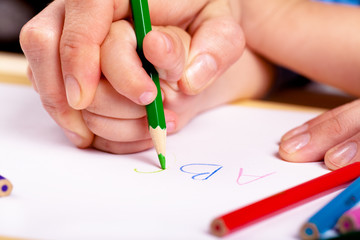Your Child’s Progressions in Handwriting
by Jenna Zellner, OTS
Kids Place Student Occupational Therapist
Handwriting acquisition is a crucial learning process necessary to get children prepared for school and adult life. Similar to a child’s physical development, handwriting skills follow a sequential progression.
First children develop precursor readiness skills which consist of drawing simple shapes. The progression is as follows: vertical line, horizontal line, circle, cross, oblique lines, square, and triangle. This developmental progression ranges from 18 months – 5 years. Children will then progress to capital letters, followed by lowercase letters and numbers.
An important component of handwriting is the child’s ability to maintain a grasp on the writing utensil. A mature pencil grip, referred to as a dynamic tripod grasp, utilizes the thumb, index finger, and middle finger. It is commonly developed by 4.5 – 7 years of age. An atypical grip can lead to poor letter formation, decreased writing speed, muscle cramping and fatigue.
There are numerous factors that can impact a child’s handwriting development including ergonomic factors, sensory processing, cognitive deficits, learning disabilities, vision, and more. Below are recommendations that can be implemented within the child’s home to assist children in developing pre-handwriting and handwriting skills.
- Body Positioning–the first and easiest step to being successful in handwriting activities is correct body positioning. It is important that the child’s feet are stabilized on the floor with their ankles, knees, and hips at 90 degrees. The paper should be slightly tilted, and the non-dominant hand should be used to stabilize the paper
- Children learn through imitation – when teaching new shapes, letters, and numbers, it is recommended to first demonstrate and provide the child with assistance to aid the child’s understanding of the formation.
- Multisensory learning – research demonstrates that the more senses incorporated when learning, the better our brainis able to retain the information. To increase the child’s engagement and assist with long term retention, it is recommended to use items such as shaving cream, play dough, or finger paint in handwriting activities. Also incorporate tangible tools such as Popsicle sticks, toothpicks, or wiki stix to help assemble shapes and letters.
- Facilitating a tripod grasp–smaller writing utensils such as broken pencils or crayons promote children to utilize a tripod grasp. Placement of paper on a vertical or tilted surface will help promote proper wrist extension, versus wrist flexion. It is also recommended to promote hand strengthening activities that will facilitate a tripod grasp such as using tongs to pick up items, peg boards, or peeling stickers.
Occupational therapists work with individuals to increase their independence in everyday occupations. For the pediatric population this includes handwriting to increase their success in communication and academics. It is important to remember that each child’s development is a unique and individualized process. If you have concerns or questions regarding your child’s handwriting development, please speak to your child’s occupational therapist.







